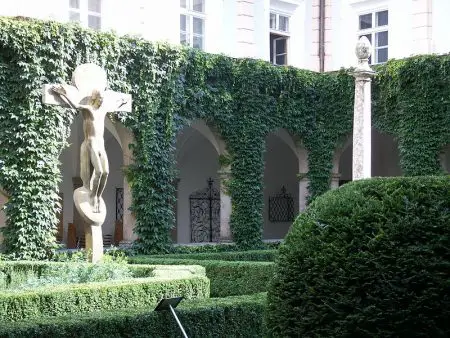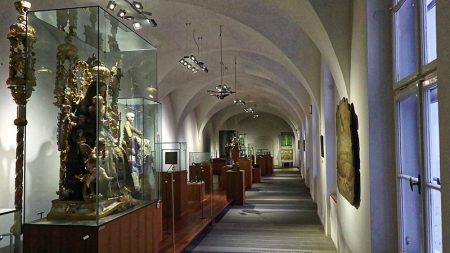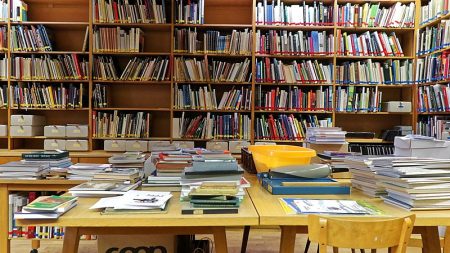Considered to be one of the best regional heritage museums in Europe, the Tyrolean Folk Art Museum is located beside the Hofkirche and across the street from Hofburg making up a fantastic trio of attractions that may well consume more than one day. Innsbruck was the haunt of royals and kings and their memorabilia fill up most of the museum coffers in the city. The Tyrolean Folk Art Museum presents a welcome change… a peek into the lives of the commoners, the working class and incredibly talented craftsmen who populated Tyrol.

This is in short, one of the most relatable museums you will see in Innsbruck and though named ‘Folk Art’ this is indeed a great example of an Anthropology museum (one of the best in Europe). The Tyrolean Folk Art Museum is a good family oriented destination… the attractions inside will appeal to visitors of all ages. Teens and slightly older kids tend to love the spooky fictional character ‘Lucifer’ who takes tourists through tours of the museum.
History
The Tyrolean Folk Art Museum lives in 4 wings of an ancient Franciscan Monastery that stood enclosing a beautiful arcaded courtyard. This renaissance style building was built in 1553 under the supervision of Emperor Ferdinand I at roughly the same time as the Hofkirche and under the supervision of the same builder (Nikolaus Turing elder).
After Turing’s death the plans of the famed architect Andrea Crivelli were used in finishing this building. In 1888 the Tyrolean Trade association made a decision… they wanted to build a superiorly crafted trade museum ‘Tiroler Gewerbemuseum’ showcasing Tyrol trades and lives and the museum should be centred in the capital of Tyrol (right now that’s Innsbruck). A large collection of craft items from different parts of the world were collected and these were meant to represent the talents of the Tyrolean craftsmen.
In 1903, an extensive collection was developed which was under the ownership of Chamber of Commerce and Trade and then much later it was relocated to an old Franciscan monastery… the venue remains the same today. Around 1926, the exhibits were handed over to the County of Tyrol and a public appeal was raised citing the need of hosting the now vast collection in a publically accessible location.
The museum was founded in 2000 but in 2008 it went under a massive reorganisation/ reconstruction phase and now sports a totally different look.
What To See & Do
Set apart a little time for admiring and clicking some pictures of the Neues Stift (New Abbey) that’s structurally attached to the Hofkirche. This lovely renaissance style building has 3 floors and enclose a pretty portico courtyard. This is a listed building that’s part of the imperial complex (i.e. Silver chapel, Noblewomen’s Collegiate Foundation, Hofkirche, Hofgarten, and Ball Games House). If you are a lover of architecture/ photography/ history then you might want to ramble around the whole imperial complex that’s the centrepiece of the old town and reserve a separate day for seeing what’s inside the Tyrolean Folk art Museum.

Remember, that many of the objects housed in the Tyrolean Folk Art Museum date back to the pre First World War era. The objects came from the old county of Tyrol that includes the Trento province (southern part of Trentino region) and the valleys of Ladin around the Dolomites. The collection is very inclusive… it represents the peasant strata, the middle class/ working class besides the nobility. Though artisan craftsmanship was the primary (and oldest theme) of the museum, it now houses common items of domestic use too.
The crafts work spans fine art, applied arts, domestic industry, traditional costumes, popular piety and even costumes of that era. A tryst with the Tyrolean Folk Art Museum not only showcases the incredibly rich heritage of the Tyrol region and its different forms of craftsmanship but also tells the story of how its different cases of citizens lived, worked and expressed themselves. The museum is divided into three floors and has many sections; the most important of which are described below.

Lucifer
A strange scary figure from Nikolausspiel called ‘Lucifer’ is the official guide for the Tyrolean folk art museum. With bulging eyes and wild hair, the figure stands at the entrance of the museum and those who are conversant with Indian Mythology will note its resemblance with Rakshasa. The eerie voice of Lucifer calls out from speakers in many rooms and elevates the ambience of the museum.
Plump Year
This museum section is entirely devoted to the celebrations and festivals that happen all through the year in Tyrol. Imaginatively named the Plump Year, the name is an indication towards the prosperity of the Tyrol region as well as the vast number of celebrations, traditions and festivities that fill up a typical year in Tyrol… making it plump!!! This space traces ecclesiastical rituals and customary celebrations through different ages. Thematic radio music keeps on playing and adds life to this section. There are crafted miniatures that recreate village fairs, events and festivities in full swing.
Precarious Life
Though this section is rather distressingly named, the precarious life doesn’t only talk about the worries and dangers of common life. There is a board outside though that details how life was precarious in those times due to accidents, sudden death and the dominance of sudden bouts of illness. To safeguard their lives, from health and prosperity people turned to superstitions, black magic and voodoo and some of the rites are displayed in vivid detail.
A matured audience will like the way each stage of life (from pregnancy to death) are represented here and there are explanatory connections to beliefs, rituals and rites connected to each stage of life. Check out the strange depiction of dowry parades, virginity committees and krampus.
Stuben
Tyrolean Folk Art Museum stands apart by the fact that it shows lovely artwork (unlikely to be found in other museums) like restored wood panels. It’s amazing to think that this building contain around 12 restored wood panelled parlours from other buildings… in short one building containing bits and pieces of other buildings. These panelled pieces date back to different periods like Goth, Renaissance, Rococo and Baroque. Historians say that these panels were part of rich houses and mansions within the Tyrol region.
There are entire reconstructed rooms that had belonged to peasants, working class as well as aristocrats… thus showing different levels and facets of Tyrolean life. Themed radio music adds special charm to this section. Parlours in that era were places where people ate, talked and spent time in participating in different events like weddings, displays of dead bodies etc. In one parlour, the body of the deceased (a model of course!!!) is laid down and people are shown sitting and mourning.
Mangers / Miniaturen des Evangeliums’
Named Miniaturen des Evangeliums’, this is one of the most visited parts of the museum. There is a huge collection of mangers made of different materials in the museum. These include wax, earthenware, paper and wood mangers…some of which date back to the 18th century. There are more than 20 cribs and viewing them together you can understand the history of cribs in Tyrol. The Baroque style cribs and the oriental cribs are especially beautiful. If you have visited Hofkirche then the Lettner (a beautiful 19th century crib made by Michael Ram) must have struck your eye. This crib is sourced from the Tyrolean Folk Art Museum crib collection.
Krippen
This is the anteroom of the space that displays cribs/mangers. Here you will be able to see lovely displays of the miniatures of the Gospel stories. In fact the Tyrolean nativity scenes right from Baroque to present day are shown imaginatively.
Study Collection
It is also interesting to walkthrough the big collection of artefacts here as they highlight different aspects of the lives of the Tyrolean commoners. There is a permanent exhibition of traditional clothing, tools, household ware, furniture, religious folk art etc. that showcase the traditions and customs of the many generations of householders who lived in Tyrol. The artefacts here range from trade to craft to items of domestic use and cultural identity.
Follow the digital museum guide to gain a better understanding of the collections. Some of the highlights are beautiful statues of St. Sylvester, St. Michael, St. Barbara and Maria Lactans as well as the artistic paintings of St. George and St. Kümmernis. There is a lovely precious wood chess board and a model miniature of a procession. Even the objects of common use and trade seem very pretty like the spinning wheel, wool carding machine, milk buckets, wardrobe, storage chests, boxes etc. The kitchenware like wooden rolling pins to crafted baking copper moulds are also exceptionally artistic.
Trade/ Schein und Sein’ [‘Illusion and Reality’]
This is a section that almost looks like a medieval photo studio. There are historical models wearing traditional costumes and they are colourful, vibrant and larger than life. These 48 figurines are mainly made of wood and are dressed in Tyrolean festive costumes that show how people dressed around the 18th and 19th century in this part of the world. Remember, that these are slightly idealised versions of dresses that people used to wear and are intended for effect.
The stately looking Tyrolean festive costumes are especially interesting to look at. There are antique paintings too and they feature unusual subjects like ‘man with three faces’ and towel holder with ‘half woman half skeleton’. You will notice a glass sheathed mannequin dressed like an Indian chieftain as he has exorbitant headgear that’s full of animal furs, fox tails and bird feathers while his necklace has boar tusks and hands clutch a long handled spear. The information board says that he is Meraner Saltner… a traditional vineyard keeper of Tyrol whose purpose was to scare away trespassers and thieves.
Masks
An entire section is devoted to masks… there are carnival masks, funny masks, heroic masks and grotesque masks in a range of colours, shapes and expressions. There is even a TV screen that captures faces and movements in a video footage style. You can turn the knobs provided below and a series of masks appear to cover your face and show you different looks. Kids and teens simply love this section and it will be difficult to drag them away.
As you reach the upper floor of the museum, don’t forget to go up in the balcony and peer down at the ‘Black men statues’ that flank the Sarcophagus of Maximilian. Straight ahead, you will see the grand church organ of the Hofkirche. Of course, to get a closer look at all this you need to buy the Hofkirche ticket too.
Multimedia Preview
Don’t miss the multimedia preview of the museum that succinctly demonstrates the historical background to the Hofkirche and the Emperor Maximilian I . . . the political and religious environment of Maximilian I is thoroughly explored and this makes for a good introduction to the Hofkirche… all the more reason as to why you should visit the Tyrolean Folk Art Museum first and then the emperor’s famous tomb. Remember, that this is the same multimedia preview that’s offered before you enter the Hofkirche court church so if you aren’t planning on seeing the Hofkirche immediately afterwards then skip this for a later time.
There are not many information boards inside the museum and you can feel the need for more interpretation. Also, the lighting is a bit low in some places (intended for dramatic effect maybe) but it does make understanding the exhibits a bit difficult. Walking through the whole museum and seeing/ absorbing all the exhibits will not take less than 2 hours.
Open Hours, Tours & Tickets
The Tyrolean Folk Art Museum is open from Monday to Sunday from 9 a.m. to 5 p.m. This is more off a do-it-yourself kind of museum and the audio guide should be sufficient as an accessory. On some Sundays special family oriented tours are organised.
There are two special rooms dedicated to children’s activities and workshops on crafts, history and culture. Folk dance programs and musical shows (featuring traditional Tyrol costumes and instruments) are also organised by the museum authorities. Calling/ emailing the museum authorities to know the details and timings of these events is the best option.
The Tyrolean Folk Art Museum is a part of the Tyrolean State Museums and most people opt to buy combined ticket for the Tyrolean State Museums that costs about 11 euros. This will allow you to visit the five Tyrolean State Museums, including Das Tirol Panorama (360 degrees mural painting of Tyrolean Freedom Fighters), Zeughaus, Ferdinandeum/Landesmuseen apart from Hofkirche. For anyone interested in history and culture of the Tyrol region… this is a good offer.
The combined ticket (exclusively) offers the audio guide (multi language including English) that details the attractions inside the Folk Art Museum as well as Hofkirche. This is of great help while visiting this particular museum as the signage inside (especially for non-german speakers) is insufficient for comprehensive understanding. It’s rather disappointing to note that while there is an English version of the audio guide, it’s comparatively less fluent and explanatory than the German version. For getting the audio guide you need to deposit a valid ID.
Sometimes the museum authorities provide a hand held device which you can point in the direction of the displays (all of them have barcodes) and the description of the display pops on the device screen. Ask for headphones if you get the hand held devices… the loudspeaker doesn’t work easily.
Entry is free for anyone under the age 19 and for holders of the Innsbruck card. There is locker storage facility for anyone wishing to deposit rucksacks, baggages etc.
There is a café selling hot beverages and snacks and a small gift shop on the premises.
Location & Contacts
The best way to reach the Tyrolean Folk Art Museum is to walk through the Old town and imbibe its atmosphere before you go on to learn about the lives of its inhabitants through the museum! If you decide to take a bus to the old town then 4123 and 4125 will take you near Museumstrasse and 4127 will take you to Hofburg (both of these are near the Folk Art Museum/ Court/court church). The nearest parking facility (paid) is the Congress Garage.
Remember that the Folk Art Museum and the Hofkirche share the same entrance. Skip the big main church door and go a little left and you will find a smaller door that provides entry to the Tyrolean Folk Art Museum. In fact buying just the folk art museum ticket will get you inside a part of the Hofkirche (balcony) and you can get a bird’s eye view of the emperor’s grand tomb… a good way of saving money for those who don’t wish to see the Hofkirche up close.
Universitätsstraße 2, 6020 Innsbruck
Phone +43 512/594 89 – 510
Email: [email protected]; Website
 A travel addict. Still celebrating the day when he quit his high-profile corporate job to pursue his passion for travel writing.
A travel addict. Still celebrating the day when he quit his high-profile corporate job to pursue his passion for travel writing.